Ways to Improve Your Winter Landscape
Posted on Wednesday, April 11, 2018 · Leave a Comment
During hard winters like this, when we tend to be somewhat housebound, it’s important to have a landscape that we can enjoy from indoors. When I first gardened I only grew vegetables and flowers, which disappear from view in winter. But now I delight in growing trees and shrubs, and placing stones and whimsy in the garden.
When I do gardening consultations I often ask to go inside the house. I want to look out the window from the kitchen sink, and to sit in the armchair by the picture window. After all, most of us spend more time indoors in the winter than we do trudging around the garden on snowshoes. I need to see more than snow outside.
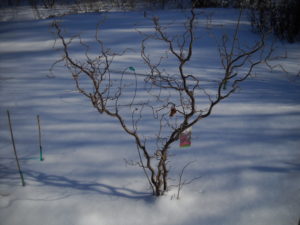
Harry Lauder Walking Stick
One of my favorite woody plants for winter viewing is a twisted, curly-branched shrub or small tree called Harry Lauder’s walking stick (Corylus avellana ‘Contorta’). This is a type of hazelnut that has been propagated vegetatively from a mutant plant found in a hedgerow in England in the mid 1800’s. It was named after Scottish entertainer Harry Lauder who was known for his singing and comedy routine. Around World War I he was the highest paid performer in the world.
Harry Lauder’s Walking stick gets to be about 10 feet tall and wide, but I have pruned mine to stay smaller than that, about six feet tall and wide. I use it in a flower bed that borders my vegetable garden. Mine has purple leaves which are outstanding in the early summer, all dark and shining, but most have green leaves. It does not, however, produce any nuts. It does best in full sun with rich, moist soil.
Over the years I have installed a few standing stones. They contrast nicely with flowers in the summer, and better yet, they stand out in winter. I have chosen stones that are 3 to 4 feet long and quite narrow.
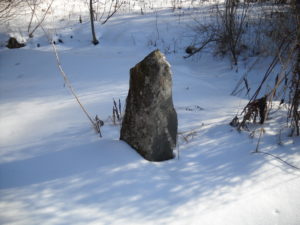
Standing stones are wonderful in winter
When I install the stones, I dig a hole that is mushroom shaped – a cylinder down 18 to 24 inches, then blooming out at the bottom. Before placing the stone I pour concrete into the hole and make sure it spreads out to the sides. The mushroom shape makes a good solid footing. That way they are steady, even after time. Years ago I installed one in the Lebanon, NH Mall that stands nearly five feet tall, and it has never budged.
Strings of tiny blue lights adorn my Merrill Magnolia behind my house. I turn them on in the late afternoon, and they brighten my landscape – and not just at Christmas time. I use these all winter, and find them good for brightening my spirits on dar,gray afternoons. With snow on the branches, the magnolia just shines. I love it for its big, furry buds and their promise of a thousand large, white and lightly fragrant blossoms in late April.
Snowmen are not just for kids. Snow sculpture is a gamble, of course. We could have a thaw and a hard rain the day after you spend an entire afternoon building a whimsical figure. I love seeing them and know the young at heart will always build a few.
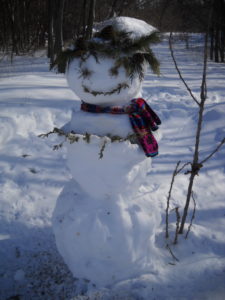
Winter Whimsy
Dartmouth College in Hanover, NH is known for the snow sculptures made each February for its Winter Carnival, and they are worth a trip to see. There is usually one giant sculpture on the Green, and smaller ones around the campus. But check on-line before making a trip to see them. I’ve heard that enthusiasm for getting cold and wet is diminishing. Kids today! (Truth be known, when I was a student at Dartmouth I did not participate much in building ice sculptures).
The old fashioned peegee hydrangea is a wonderful plant in winter, and if you don’t have one, you should. Most hydrangeas bloom in August with big pompoms of white florets. When frost comes the flowers turn brown, but most stay attached to the stems. In winter they hang one, decorating the white landscape and reminding me that summer is coming – eventually.
Actually, my favorite of the hydrangeas is one called ‘Pink Diamond.’ This has flower panicles that are longer and more pointed than the standard peegee. The stems are stronger and less likely to flop, too. These are great in winter.
A well-pruned apple tree is glorious in winter. Most gardeners prune apples in the spring – it’s warmer and easier to work then. But if you do prune in the fall or winter, you will be rewarded with a living sculpture that stands out against the snow. Trim out all those pesky water sprouts, dead branches, and clutter. I like to say that a bird should be able to fly through a well-pruned apple tree.
Greenery is especially nice in winter. That may account for the number of yews, arborvitae, junipers, hemlocks, Mugo pine, dwarf blue spruce and rhododendrons that are planted in the landscape.
Maintenance of evergreens is important. I’ve seen too many tall conifers- and even rhododendrons – blocking windows of houses to recommend planting anything but dwarf plants near the house. And some “dwarf” plants are actually just slow growing and can become problematic in 20 years.
Stoke up the woodstove and enjoy this cold, snowy winter. And plan on adding some height to the garden next spring if all you see now is white.
You may reach Henry by e-mail at henry.homeyer@comcast.net or by mail at PO Box 364, Cornish Flat, NH 03746. Please include a SASE if requesting a response by mail.
Native Plants for New England Gardens
Posted on Monday, April 9, 2018 · Leave a Comment
It’s rare that I find a book that is as useful, accurate and easy-to-read as Native Plants for New England Gardens by Mark Richardson and Dan Jaffe, both on staff at the New England Wild Flower Society in Framingham, Massachusetts. This book presents over 100 species of wildflowers, trees and shrubs, grasses, ferns, vines and lianas (woody vines). And even though I grow the vast majority of plants in this book, I learned so much that I felt like a third grade boy on an outing with a PhD.
First, the authors define native plants: those that were growing in North America when the first colonists arrived. They stress, right of the bat, that it is important to put the right plant in the right place. Instead of shopping for pretty flowers, they recommend knowing about plants and seeking them out. The glossy photos of the book will help you put together a plant list; their instructions will help you decide if you have a place for a particular plant.
I have always enjoyed eating wild harvested plants. The book covers ramps, which I grow, but also other wild edibles I grow – including two that I didn’t know are edible.
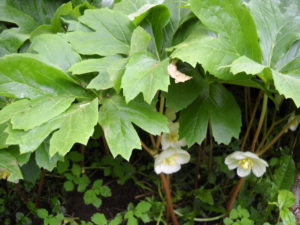
Mayapple
I have a large patch of Mayapple (Podophyllum peltatum). As the authors point out, it spreads robustly and shades out other plants. The blossoms appear beneath the big, wide leaves and are not easily seen; they suggest planting it on a steep incline, so that one can see them – and the fruit, bright red “apples” when standing below the planting. I have seen the fruit, but never knew it was edible until reading about it. Apparently the fruit is also eaten by box turtles. Who knew?
Another edible fruit described in the book is produced by American spikenard (Aralia racemosa). The authors note that spikenard gets big enough to serve as a handsome shrub, but since it dies back to the ground each fall, it won’t be damaged by snow falling off your roof if you plant it near the house. I grow it in part shade and it gets to be 6 feet tall and wide, and produces masses of berries each fall. The berries start off white, change to red, and end up a deep purple. I shall taste them this fall.
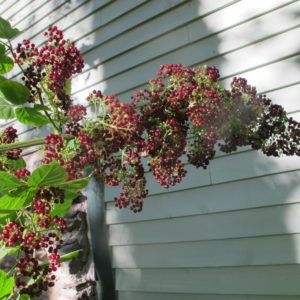
Aralia Berries
I grow all 3 of the milkweeds described in the book: common, swamp or rose, and butterfly milkweed. The authors explain the plusses and minuses of each, where to plant them. “If you are looking for a well-behaved garden plant, then common milkweed is not the best choice.” It spreads by root, they explain and is suited for “meadows, hell strips or as competition against invasive species.”
Yes, I knew that milkweeds are essential for monarch butterflies, but they point out that they also support tussock moths, swallowtails, and a variety of beneficial beetles. “The plant (swamp milkweed) seemingly supports whole ecosystems on its own, often playing host to bees, ants, and various spiders waiting to eat an unsuspecting pollinator.”
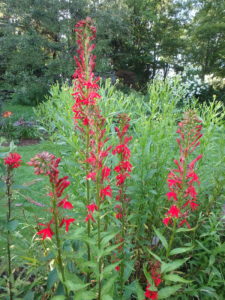
Cardinal Flower
I love cardinal flower (Lobelia cardinalis) and have grown both the native species and modern hybrids varieties in a moist, full-sun garden. I no longer grow the hybrids, as they are less hardy than the native species and have all died out. The authors refer to work done at the University of Vermont that showed that at least one of the hybrids produced only 20% of the nectar energy produced by the wild species. So hummingbirds, who love these bright red flowers, get something akin to diet nectar if you grow the hybrid variety. It’s best to avoid planting them, so read the plant tags carefully before buying.
I love the bright red leaves of staghorn sumac (Rhus typhina) growing by the side of the road, but would never consider planting it on my property. Although a native plant with fruit beloved by returning migratory birds in early spring, it can spread very aggressively and is hard to remove. But the authors introduced me to another variety, fragrant sumac (Rhus aromatica), that is smaller, “much slower growing, and fairly easy to control even in a formal garden setting.” I shall look for it, and try to learn from others who have grown it (Please e-mail me if you have grown it).
I grew up in Connecticut where spicebush (Lindera benzoin) was a wild shrub with tasty leaves and twigs that I chewed as a breath freshener. But it is hardy to Zone 4, and I got one two years ago. According to the book, it is an understory shrub that does well in moist soil. I knew it as a plant for dry shade, and hence planted it here in a dry location, and it has done fine.
What I did not know, until reading Native Plants for New England Gardens, is that spicebush is dioecious – there are male and female plants. That would explain why I have not gotten any of the bright red berries used by the authors in a tea that is “magical for fighting off the common cold and is packed with vitamin C.” I shall get another, and hope for pollination.
One last tip from the book: if you want to grow wintergreen, a low-growing ground cover with tasty red berries, plant it under your blueberries. The sulfur you give your blueberries will make the soil right for wintergreen.
I loved this book. I predict you will, too. And come spring, I’ll go to the Garden in the Woods in Framingham, MA (where the authors work) and buy some wildflowers in the nursery there.
You may e-mail Henry at henry.homeyer@comcast.net or write him at P.O. Box 364, Cornish Flat, NH 03746. Please include a SASE if you want a response by USPS mail.
Growing Plants Our Grandparents Grew
Posted on Monday, April 2, 2018 · Leave a Comment
As we lurch toward spring, I spend time thinking about my garden: What will come through this hard winter? What needs to be replaced? What new plants do I want to try? One thing is certain. My grandmother’s peony will survive, and I will feel blessed by its beauty and fragrance in June.
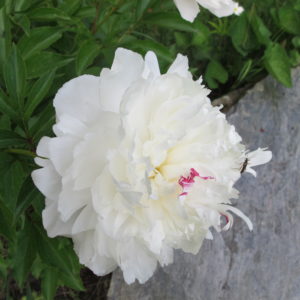
Peony Fesitva maxima that my grandmother grew
My grandmother died in 1953, when I was seven. That fall my mom dug up grandmother’s favorite peony, one called ‘Festiva Maxima’, and brought it to my childhood home in Connecticut. Years later Mom suggested I dig up and divide my grandmother’s peony and bring a piece to Cornish Flat. I did that around 1984 and the peony is still going strong, nearly 35 years later. I love the connection it has to my mom, and to my grandmother and her gardens.
Plant breeders are constantly making efforts to introduce new varieties to the garden trade. Gardeners have long been traveling to far corners of the world to find new species that will make a hit. But there is something to be said about the old varieties and plants that have proven their worth over a hundred years or more. Here are some of my favorites.
Lilacs, the New Hampshire state flower, are an old favorite of mine. They’re not native here: they originated in Eastern Europe and temperate Asia. But they’ve been in America for hundreds of years. Skiing past cellar holes of abandoned farm houses I have seen lilacs that have survived with no care for decades.
Do your lilacs a favor later this spring by sprinkling a couple of quarts of wood ashes or limestone in a 5-foot radius around each. This will make the soil less acidic, which will increase the number of blossoms you get next year. This year’s buds are already in place, so blooming will not be affected.
I collect gardening books, and was recently perusing one called, “The Practical Flower Garden” by Helena Rutherford Ely, which was published in 1911. Ms. Ely said about her garden, “A long hedge of hydrangeas still remain, although I now exclude them from my vision, and regard them as if they did not exist.”
You may wonder why, pray tell, she shunned these plants? She explained, “These brave plants are so hardy and free-blooming that they have found a place from one end of the country to the other, and are grown everywhere, yet, because of their very merits which made them so universally grown, they have become distasteful to many.” Not me. I love hydrangeas.
The common orange daylily falls into the same category, I suppose. It’s indestructible, spreads by root and everyone has some – unless some ambitious gardener ripped them all out. I admit that I have dug out plenty of them in my day and replaced them with other perennials, including hybrid daylilies of other colors. My main objection is that, with time, they will take over beds and run out other plants. Still, I recognize that it is a good sturdy plant.
Some gardeners won’t give garden space to beebalm, another old favorite, though I love it. Yes, it spreads even faster than orange daylilies. But if it steps out of bounds, it pulls easily. If you leave some of the root in, of course, it will come back. My favorite weeding tool, the CobraHead weeder (www.CobraHead.com or 877-962-6272) does a great job of teasing out roots, so I have no problem with them.
Beebalm comes in several colors and all attract bees, butterflies, and hummingbirds. Two years ago I discovered a dwarf beebalm on the market. I believe the variety was called “Petite Delight”. It didn’t spread, and only grew about 12 inches tall. You might want to look for it this spring.
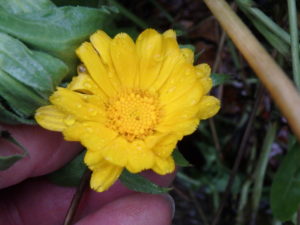
Calendula Still Blooming in November
Then there are old favorites that as annuals, come back for me without any work. Calendula was grown by Thomas Jefferson. I have it free every year in my front walkway beds. I planted some years ago, and it self-sows every year, coming back in large numbers. It’s a yellow daisy-like flower that blooms well past frost.
Then there are annual poppies. I love them. Their seed pods contain hundreds of tiny seeds that they spill on the soil surface. I try not to disturb them when planting other things. I have them willy-nilly in the vegetable garden, adding color to lettuce and tomato rows.
Salpiglossis is an elegant old flower with a velvety texture and a range of colors, often in purple, red or mahogany with yellow stripes near the throat of the petunia-like blossoms. I first saw it at the Celia Thaxter garden on Appledore Island off the coast of New Hampshire. Preservationists have re-created her gardens, and they can be toured. She was a poet who lived from 1835-1894, and who loved flowers.
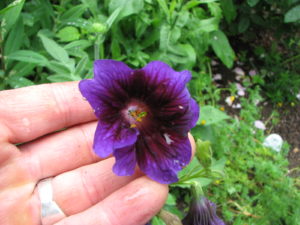
Salpiglossis
Salpiglosssi, also known as painted tongue, needs to be started indoors 8 weeks before last frost, and germinated in the dark. No lights. Then 16 hours of lights a day, with dark nights. Fussy. Some good nurseries will have seedlings for sale, which might be easier than starting your own. Or you can direct seed them outdoors in June.
So sit back and do some planning now, in mud season. But don’t just drool over pictures of new cultivars. Some of the old favorites are best.
Read Henry’s blog athttps://dailyuv.com/gardeningguy. You can find his past newspaper articles there, and many extra photos. E-mail your questions to Henry athenry.homeyer@comcast.net.
Forcing Flowers on Spring-Blooming Trees and Shrubs
Posted on Monday, March 26, 2018 · Leave a Comment
I recently got a new tool that I’ve been using to pick stems of forsythia and pussy willows. Stems of spring-blooming shrubs put in a vase with water will bloom earlier inside than they would outside – and I’m ready for blossoms. Often the best buds are high up where I can’t reach them without a ladder, so I was delighted to find a pole pruner that both cuts branches, and holds onto them so that I don’t have to search for them after they’re cut. It holds on, allowing me to place the branches neatly in a pile that I will bring indoors.
I got the tool from The Wildflower Seed & Tool Company (www.wildflower-seed.com or 800-456-3359) at the Philadelphia Flower Show. They come in three sizes: a 2-footer that is designed for picking roses, one that extends from 4 to 6.5-feet, and a long one that will extend from 6 to 10 feet in length. The extending pole pruners have pivoting heads. They range in price from $59 to $114 plus shipping. I have the mid-sized tool, and it did a great job helping me pick forsythia stems.
Since we are having an extended winter this year, forcing blossoms is important to my sanity. I found it only takes about a week now from the time I cut forsythia branches to the time they blossom indoors on a sunny window sill and last for about a week. Other shrubs that can be forced include apple and crabapple, magnolia, honeysuckle, quince, serviceberry (shad bush) and flowering dogwood.
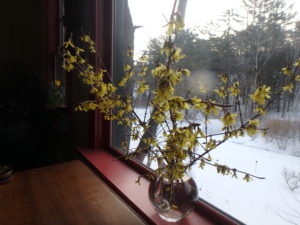
Forsythia forced to bloom indoors
My gardening grandfather grew lots of forsythia. He had a double row of them probably 50 feet long and 10 feet tall. As children, my sister Ruth Anne and I loved the forsythia because we used this huge cluster of greenery as a respite from the heat of summer – and the prying eyes of adults. In between the two rows was a vacant space, just right for kids to sit in and hide. We’d crawl inside and disappear.
Good varieties of forsythia in cold country include New Hampshire Gold, Meadowlark, Northern Gold and Vermont Sun. All those are hardy to Zone 4. There may new varieties as well.
Forsythia branches tend to flop when they get to be a certain length, and where they touch the ground they will root in, starting a new bush. Let one root for a year, sever the connection from the mother plant, and you can dig it up and plant it elsewhere. This means, of course, if you don’t prune those longer branches, your single plant will become a clump, and before long you will have a mess.
Most bush honeysuckle species are on the invasive species list. These include Lonicera bella, L. morriwii and L. tatarica. So if you have wild bush honeysuckle I encourage you to cut plenty of stems and bring them inside for forcing. The fewer flowers left on the bushes, the fewer seeds, and thus fewer new bushes spreading out over the landscape. I’ve never forced them before, but will try to find some this year. They are common alongside the road where I live.
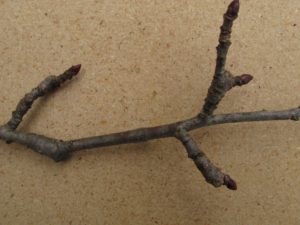
apple fruit spurs
This is the time to prune your apples and crabapples, and the stems you remove can provide you with nice flowers and foliage. But not all apple stems have flower buds. What you want are branches with fruit spurs on them. These are 2 to 4 inch-long spurs (short branches) coming off mature branches. And a fruit spur must be 2 years old or more to have blossoms.
The buds you see on an apple spur will contain anywhere from one to six flower buds, along with leaf buds. Water sprouts those vertical shoots the diameter of a pencil, do not generally have any flower buds. Fruit spurs are most common on branches that are at a 45 to 60 degree angle from the vertical.
Flower buds are always bigger than leaf buds. When choosing stems to cut, look for buds that are fat or round. When pruning blueberries, for example, I am careful not to cut off many fruit buds. The difference is obvious. Leaf buds are small and pointy, flower buds are round and plump.
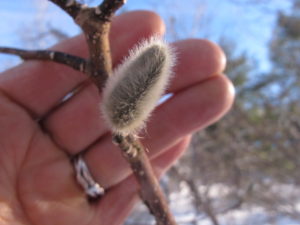
Magnolia Flower Bud
Shrubs like forsythia or honeysuckle are very forgiving. You can cut stems almost anywhere, and they will recover. When cutting stems from trees like magnolia or apple, slow down and take more time. Don’t leave stubs (or short remnants of branches). Cut each branch back to the place where it joins a bigger branch, or the trunk. If you leave a stub it will not grow, and will have to rot back to the bigger branch to heal. That might allow insects or disease to enter the tree.
When deciding where to make your cuts, see if you can recognize the branch collar. That is a swollen area at the beginning of a branch, and is often wrinkled. Leave the branch collar. Never remove the branch right back to the trunk with a “flush cut.”
Right now, when warm spring weather is normally present, our shrubs like forsythia will bloom within a week indoors. And those pussy willows we all love? They are fuzzy and cute already. If you put them in a dry vase, pussy willows will stay looking cute for months. So put on your boots, and go cut some.
Read Henry’s blog at https://dailyuv.com/gardeningguy. You can find his past newspaper articles there, and many extra photos. E-mail your questions to Henry at henry.homeyer@comcast.net.
Gardening: The Slowest of the Performing Arts
Posted on Monday, March 19, 2018 · Leave a Comment
March has been ferocious. None of this “In like a lion, out like a lamb” business. The entire month has been a Tyrannosaurus Rex, if you ask me. I’ve done more roof-shoveling this month than I usually do in a year. My poor snowdrops, usually showing me their noses in early March, are still deep in snow. Sigh. But spring will come. It always does.

Snowdrops
Snowdrops, my harbinger of spring, are best planted on a south-facing hillside. That way the snow melts off early, and allows them to push up through the frozen soil. Unlike tulips, their little white flowers look downward, so one must bend over and tip the blossoms up to see inside, which is always the most interesting view of a flower – all those stamens and pistils.
My snowdrops have multiplied over the decades. I don’t know if they move by seed, or if little rodents dig them up and move them around. I suspect it is by seed since they tend to move downhill into the lawn. Fortunately, they get all the sunshine they need to re-charge their batteries by the time I’m ready to mow the lawn. Daffodil leaves, on the other hand, don’t dry up until July, so I don’t plant them in the lawn.
Glory of the snow (Chionodaxa lucilae) is another small early bulb plant that will appear as soon as my snow disappears, and it has multiplied nicely over the years, too. I have it light blue, white and pink. Unlike snowdrops, the blossoms open with their faces up towards the sun – and us.
Scilla siberica, or squill, comes out just a few days after my glory of the snow and has a very intense purple color. Just a couple of inches tall, these small beauties look down, like the snowdrops. These do not multiply quickly, though their clumps or clusters do get more robust over time.
Bright yellow, school bus yellow, I associate with daffodils, and I have plenty of those that bloom in April and May. But before even the earliest are some short yellow blossoms of winter aconite (Eranthis hyemalis). I just learned that they are related to buttercups, which makes sense to me, given their color and flower shape.
Aconite are marginally hardy for me in Zone 4, but last spring I had many tiny ones, clearly first-year plants that developed from seed. I wonder if they will return and bloom for me this year. Such questions will get me outside and in the garden every day, should I ever get old and frail.
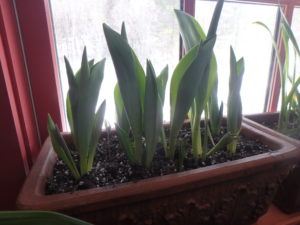
Tulips growing on the windowsill on the first day of spring
Many gardeners have given up on tulips because they are so tasty: to rodents that eat the bulbs, and to deer that consume the buds, blossoms and leaves. Not only that, most gardeners find tulips don’t return, year after year. I think of them as annuals since in year two I get half the number of blossoms I did in year one, and then only half of those come back to bloom in year three. No matter, I love them and plant them.
There are solutions to the tulip dilemma. First, I plant plenty each fall in clay pots and store them in my cold basement. Then, after 4 months of cold storage, I bring the pots into the warmth of the house and they bloom on the window sill. Right now I have some budding up, getting ready to bloom.
At the end of President Clinton’s tenure in the White House I got to interview the White House gardener, Dale Haney. The gardeners had just planted many thousand tulips, a pink one called Hilary Rodham Clinton! I always wondered if the Bush family asked the name of that one, and how President Bush felt about seeing Hilary tulips outside the Oval Office windows, waving at him in the breeze.
.
The White House grounds, I observed, were not only served by many gardeners, but occupied by many large, fat, lazy gray squirrels. I asked Mr. Haney about them. First, he explained, that our tax dollars paid for hundreds of pounds of sunflower seeds to feed the squirrels. A well-fed squirrel is less likely to dig up tulips, he said.
He also explained that the gardeners laid down chicken wire above the bulbs – but an inch or two below the soil surface. Thus if an unusually ambitious squirrel decided to lunch on a Hilary, it would be thwarted by the screening. I’ve tried that, but it’s a lot of work – and my little corgi and two aging cats seem to deter squirrels from digging up any tulips I plant outdoors.
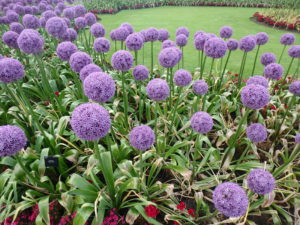
Alliums at Kew Gardens
Alliums are bulb plants that vary considerably in size and look according to the species or variety. They’re in the onion family, so not eaten by critters. I was amazed by all the diversity I saw last spring in London at the Chelsea Flower Show, and at Kew Gardens.
I’ve always had a few big ones outdoors, but last fall I planted some in pots to force indoors, as one spectacular variety I simply had to have, Allium schubertii, is only hardy to Zone 6 and would not survive outdoors here. I bought plenty of others that are hardy here in Zone 4 and can’t wait to see them perform.
Gardening – indoors or out – really is the slowest of the performing arts. Plant something, wait, hope. The anticipation, for me, is almost as important as the performance.
Henry is a UNH Master Gardener and the author of 4 gardening books. Reach him by e-mail at henry.homeyer@comcast.net.
Starting Seedlings Indoors: How, When, Where?
Posted on Monday, March 12, 2018 · Leave a Comment
Is it time to start seedlings yet? Yes, for a few things: artichokes, broccoli, Brussels sprouts, cabbage, onions and leeks, kale and peppers. Tomatoes I start in early- to mid-April, along with eggplants, lettuce, melons and squashes of all sorts. Root crops are generally started outdoors later on, but I have started beets indoors on occasion for an extra early crop.
If you want a lot of annual flowers, starting by seed can be a big saving. But, as with vegetables, you have to do it just right in order to get plants that resemble the ones you would buy at the garden center.
If I just want a 6-pack of nasturtiums, it is cheaper to buy them as plants than as seeds. A packet of seeds often costs $5 or so, though the FEDCO cooperative sell little packets for just $1.30. Those packets generally contain a gram of seeds, and the on-line catalog tells you how many seeds are in it- usually plenty (or more than enough) for a one-year supply.
Most seeds are good for 3 years. But onions, sweet corn, parsnips and spinach are only good for one year. Peas, beets and Swiss chard are good for one or two years. Flowers vary – experience will tell you, or the seed package will. If you have older seed, plant more seeds – not all will germinate, but some probably will.
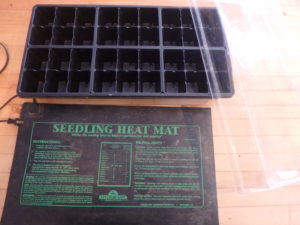
Equipment for seed starting
To get good looking plants, you need lights. Yes, there are people who start plants on windowsills, but those plants quickly get tall and leggy as they reach for light. If you want to start some lettuce seedlings in late April on a window sill, sure, you can keep them there for a month before putting them outside. But tomatoes? Forget about it.
Buy 4-foot fluorescent lights and hang them 6 inches above your seed flats. As the plants grow, move the lights up to keep them at the right distance. Now there are LED lights made for the same 4-foot fixtures you may already have, and they are supposed to be more effective and less expensive to run. They are available on-line from Gardeners Supply Company. LED lights should last for 20-plus years. I use something called jack chain, which I get at the hardware store, to hang my lights as it is easy to adjust the length of the chain.
I use a biodynamic calendar called Stella Natura (www.stellanatura.com) to guide me when to plant seeds. It uses the sun, moon and stars to determine when optimal dates are for planting. It also gives “black-out” days to avoid. I’ve tested the black-out days, and never plant on them. Sunday, April 8 will be good for starting tomatoes this year, but the 11th to 13th will be black-out days.
Seeds have a built-in heat-sensitive trigger that controls germination. It would be a bad idea for a seed to germinate in January, for example, even if there were no snow. Cold would kill the seedlings. Warm soil tells a seed that the sun is strong, has been for some weeks, and probably will continue to be strong and warm.
You can add bottom heat to your seed flats by buying electric heat mats. They are about the size of a flat, and add a low, gentle heat to warm the starting mix your seeds are planted in. They will speed up germination considerably.
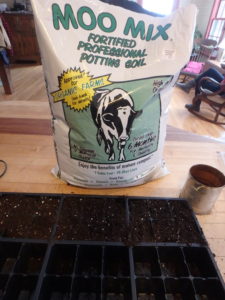
Potting Soil
Don’t even think of starting seeds in garden soil. Although I sometimes make soil blocks from compost and peat moss with some added garden soil, usually I just buy Moo-Doo brand planting mix that I put in little plastic 6-packs. I always buy the 6-packs that have the biggest cells available. Some come with 72 compartments to the flat, some 48 and others 36 or 32. I like the 32’s – they have more room for roots.
Seeds are very sensitive to drying out, especially just after they have germinated. To minimize the chances of that, I use plastic covers that fit on the flats. These are clear, allowing light to pass through, but not moisture. Safely stored, these are good for many years. You can save and wash the 6-packs but they are cheaply made and often crack or break, so I don’t bother most times.
Read the seed packets when planting seeds. Lettuce seeds need light to germinate, so just a very fine layer of planting mix or fine vermiculite will do. A big seed like a squash needs half an inch or more of cover. Generally the bigger the seed, the deeper the hole. I use a pencil to make a divot for each seed.
Because the Queen of the Garden is the tomato, I plant 2 seeds in each cell. Usually both germinate. The hard part is then snipping off one of the two. It feels awful to kill a tomato, but growing both in a small cell will result in stunted growth and completion for nutrients. And if the seedlings get too big, I transplant some into small pots.
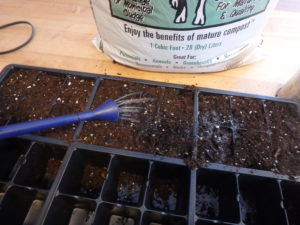
Moisten potting mix before planting
As plants grow, they quickly use up the minerals that came in the potting mix. I make a dilute solution of fish and seaweed fertilizer and use it to water my seedlings. That’s what nurseries do, although most use chemical fertilizers – sometimes pushing the plants to grow too fast. And since I am not going to use chemical fertilizers, I don’t want plants that expect them.
Starting seedlings is a sure cure for MSB (Mud Season Blues). I love watering and admiring my little tomatoes, and dreaming of them in sandwiches on thick slices of all-grain bread with rich mayonnaise. Sigh. That’s still a long way off.
You may reach Henry by e-mail at henry.homeyer@comcast.net. His website is www.Gardening-Guy.com.
Why Grow Flowers Organically? (And How to Improve Your Soil)
Posted on Monday, March 5, 2018 · Leave a Comment
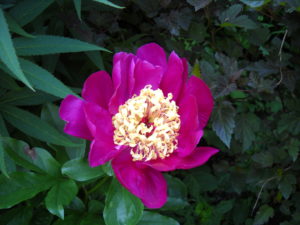
Peonies grow well with no chemical fertilizers or pesticides
When I mentioned to an acquaintance that I not only grow my vegetables with organic methods, but my flowers, too, he looked at me funny and asked, “Why? Are you going to eat your peonies?” No, I don’t eat my peonies, but I do believe they are healthier and produce better than they would be if I used chemical fertilizers and pesticides.
Mother Nature has been growing green plants for 100 million years or more, and never once has she needed a 50 pound bag of 10-10-10, a bottle of herbicide to spray on weeds or a bag of insecticide. Chemical companies have been promoting their products for 100 years or more, and some chemicals can increase flower size or help to quickly improve bad soils. But they come with liabilities, too.
Chemicals added to your lawn or garden may inhibit the growth and viability of beneficial microorganisms. Most chemical fertilizers are composed of salts of nitrogen, phosphorus and potassium. Salts dry out living tissue and can easily kill microorganisms. Too much fertilizer can dry out and kill root hairs of your precious plants, too.
Plants thrive in soils that are biologically active: soils that are full of beneficial fungi, bacteria, protozoa. I read once that a teaspoon of healthy soil can contain 5 billion bacteria, 20 million filamentous fungi and a million protozoa. Those improve soil tilth and fertility.
Some gardeners tend to think of fungi and bacteria as bad: they think of fungi as the mildews and molds that disfigure garden phlox or leaves on lilac bushes. But in the soil there are many more good bacteria and fungi than bad ones.
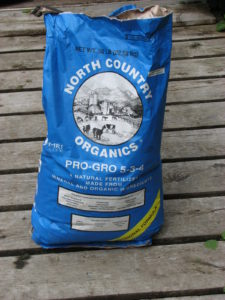
Pro-Gro Organic Fertilizer 002
Chemical fertilizer have just three useful elements, nitrogen, phosphorous and potassium. The rest is just filler. Organic bagged fertilizers are made from things like ground oyster shells and peanut hulls, dried seaweed and perhaps dried blood. So organic fertilizers have a wide range of useful minerals used by plants. Let’s look at what some of those ingredients do.
Nitrogen, the first number on a bag, is the key additive in fertilizers, as it promotes green growth. Unfortunately, chemical fertilizers often have so much soluble nitrogen that it can push plants to grow too fast. Think gawky teenage boy who grows 6 inches in one summer. Plants that grow too fast are often weak and susceptible to insects and diseases. It has been proven that too much nitrogen actually attracts insects to plants.
Organic fertilizers have a mix of soluble fertilizer and time-release fertilizer. In Pro-Gro, the fertilizer I use most often, about 75% of the nitrogen is released over time, and is made most available in warmer weather when plants are most active. That’s good. A chemical fertilizer can largely wash away in a week of rain.
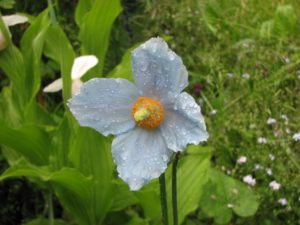
Himalayan Blue Poppy
Phosphorus, the middle number on a bag of fertilizer, is good for promoting growth of roots, fruits and flowers. It is commonly available as phosphate, and can pollute streams and rivers, causing algal bloom in lakes. Rock phosphate is a very slow-releasing form that is commonly used in organic fertilizers. Rock phosphate is slowly broken down by acids produced by fungi that coat roots of plants.
Potassium, the third number on the bag, helps plants to produce thick cell walls and protect them against dehydration and very cold temperatures. It is also involved in carbohydrate metabolism and cell division.
In a bag of organic fertilizer are many other ingredients including calcium, magnesium and sulfur. These are called secondary macronutrients because they are not needed in the quantities of the three listed above.
Calcium is involved in pH regulation of the soil (limestone contains calcium and is commonly used to increase the pH), and in cell metabolism and building proteins. Magnesium of part of the chlorophyll molecule involved in photosynthesis. Sulfur is necessary for making proteins and fats. It is what gives onions their bite.
What else is in an organic fertilizer? Iron, chlorine, manganese, zinc, copper, boron, molybdenum and nickel. These are called micronutrients as they are used in very small quantities, but each is important to plants. They are not included in a chemical fertilizer.
Compost, which is made from once living beings or stuff produced by them– whether manure or leaves, for example – contains the minerals cited above. It also improves soil structure and a soil’s ability to hold moisture and drain well. Adding compost is key to getting great soil. You can buy it by the truckload, or by the bag. Compost sold in bags should smell like good earth. It if smells like fresh manure or sulfur, you don’t want it.
It’s too early for soil improvement, but spring will be along soon. Don’t do much until the soil dries out. My garden does well each year and I am rarely troubled by insect pests. I believe that the moderate growth promoted by compost and organic fertilizer is a key reason for my “good luck” in the garden.
Read Henry’s blog posts at https://dailyuv.com/henryhomeyer. You may reach Henry at henry.homeyer@comcast.net. Henry is a UNH Master Gardener and the author of 4 gardening books.
8 Steps for Pruning Trees to Perfection
Posted on Tuesday, February 27, 2018 · Leave a Comment
I find it amusing that fruit tree pruning and income tax preparations should take place at about the same time of year, and that many gardeners put off each until the last moment. You might want to start pruning now, instead of trying to do it while adding up your gasoline expenditures and medical expenses.
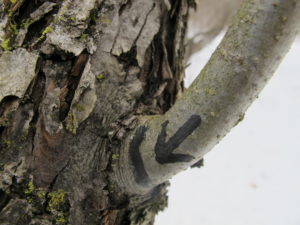
Branch collar and line to show where to cut
Below are 8 steps involved in properly pruning a tree. All are designed to create a healthier, more productive tree. By removing clutter you will allow direct sunshine to get to every leaf and wind to circulate, reducing chances of fungal infections. Keep in mind, too, that you can sculpt your tree, too, creating a thing of beauty. For me, that’s an important part of pruning.
- Remove all dead wood. You can tell if a branch is alive, even without leaves, by scratching it with a fingernail. Live twigs will show green when the outer layer of bark is removed. Dead branches will have dry, unhealthy look.
- Remove any diseased or damaged branches. Cracked branches should be removed, though I have had some grow back together by wrapping them tightly for a couple of months.
- If two branches are touching, they will rub and damage bark when the wind blows. Remove one branch.
- Branches should grow outward, away from the center of the tree. Remove any branches that aim back towards the middle of the tree.
- Branches will grow toward the light, and often two will try to fill the same space. If two are growing parallel to each other, remove one of them.
- Many fruit trees grow lots of vertical sprouts each year, each the diameter of a pencil. This is the tree’s way of producing more leaves to feed the roots, but these shoots, known as “water sprouts” will clutter up the tree. Remove most (or all) water sprouts. If you don’t do this every year, the water sprouts will become full-sized branches and your tree will a mess!
- Correct bad crotch angles. Often a branch will grow tight to the main trunk or another branch, creating a tight crotch angle. As the branch gets larger the two will grow together and bark will be swallowed up between them. This is a weak spot, and likely to split if the branches are loaded up with wet snow, or ice. Remove the offending branch – and the sooner the better. Removing a big branch is harder on the tree, and more difficult for you to do.
- Remove low branches that will interfere with mowing. If you have small children you will want them to be able to pick fruit, but you can still create room for the mower and accommodate kids.
Not all trees and shrubs should be pruned now. Spring-blooming shrubs like lilac and forsythia can be pruned, but you will lose blossoms. It’s better to prune after they bloom. Evergreens should be pruned in July after they have produced their new growth. Maples and birch should be done in early summer – right now they will “bleed” sap in large quantities.
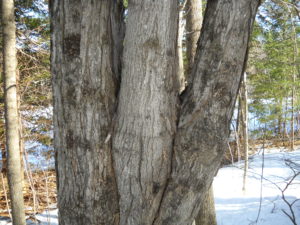
Trees with bad crotch angles
How many branches can you take off now? Arborists say that 20% to 25% is fine. More than that, and you will start to starve the roots – leaves provide the food that roots need. That 25% figure is actually of the leaves, not the mass of wood. Dead wood doesn’t count, nor stems that support branches but have no leaves. Taking too many leaves may stimulate the tree to produce large numbers of water sprouts. That said, I once cut a huge lilac to the ground, and it came back nicely. That’s not recommended, however, and it would kill many other tree species.
Lastly, it’s important to know where to make your cuts. Branches generally have a “collar” that is at its attachment point. This collar is wider than the branch, and bark is often wrinkled. You need to cut just beyond the branch collar so that it can heal quickly and avoid infections. If you make a flush cut against the trunk, you open a wider area to diseases and insects, and remove the portion that produces protective compounds to avoid disease.
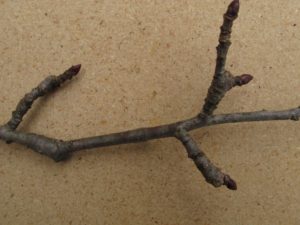
apple fruit spurs
Pruning should be on your spring calendar just as garden clean-up is on your autumn calendar. But unlike clean-up, pruning get easier with time. A well-pruned tree is better behaved than one that has been ignored for 5 or 10 years. Get some good loppers, by-pass pruners and a pruning saw and get to work! And bring inside a few branches to put in a vase. They may reward you with some nice blossoms long before the outdoor trees do.
Read Henry’s blog posts at https://dailyuv.com/henryhomeyer. You may reach Henry at henry.homeyer@comcast.net. Henry is a UNH Master Gardener and the author of 4 gardening books.
How Will Cold Weather Affect Our Gardens?
Posted on Tuesday, January 2, 2018 · Leave a Comment
We’ve had some very cold weather recently. And although I hear gardeners at the post office or country store complaining about the cold, the weather has been normal for this time of year. It’s January, after all, and it’s supposed to be cold. It’s even good to have some deep cold.
I live in a Zone 4 location. That means that during an average winter the temperatures will dip down to between minus 20 and minus 30 degrees. So far I’ve recorded temps in the low twenties – below zero. Balmy? No, but still in the normal range for my climatic zone.
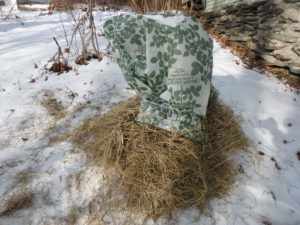
Hay and fabric to protect kousa dogwood
Trees, shrubs and perennial flowers can be damaged or killed if the temperatures get too cold, especially if the temperature stays low for a number of days, or if there is a strong cold wind. Snow cover is good, as it serves as a blanket over the roots. We’ve had a long run of cold days, and we’re all shivering a little, even our plants.
The US Department of Agriculture rates each state with a zone depending on averages. These zones reflect the average extreme minimum temperature over a 10 year period as follows: Zone 3: -40; Zone 4: -30; Zone 5: -20; Zone 6: -10; Zone 7: 0 degrees Fahrenheit. If you don’t know your climatic zone, Mrs. Google will show you a Plant Hardiness Zone map covering your area, just ask her.
So what is good about cold times? As my late sister, Ruth Anne Mitchell, used to say, “Thirty below keeps out the riff-raff.” By that she meant invasive pests like the wooly adelgid that devastates Canadian hemlocks in southern New England. As the climate warms, they have been slowly moving northward. This year might knock back pest numbers.
Late blight, a fungal pest which can devastate tomatoes and potatoes, and can overwinter in Georgia but will not survive in New England if the soil freezes. Of course if we have a deep snow cover, the soil will not freeze more than a few inches. That is why you shouldn’t let “volunteer” potato plants remain in the garden next spring if you had any late blight last summer. Late blight can winter-over in potatoes, but not in foliage. Unfortunately early blight will survive our cold winters, and comes back every year.
I am sometimes grow perennial flowers that are rated for use only in warmer zones. I have plenty of Zone 5 plants, and even try some that are only rated for Zone 6. If they are well established and have the growing conditions that make them do well, they will often survive for several years before a very cold winter like this one does them in. But by then I’ve had several years of enjoyment.
Very few perennials last forever. Only peonies really can be expected to last for the rest of your life. I have one from my grandmother Lenat’s garden – and she died in 1953. My mom grew it, and then gave me a piece of it in the 1980’s. I hope one of my grandchildren will want it when I die.
You can take measures to protect shrubs and small trees from cold weather, but I don’t know that it really makes much difference. I know some people wrap their tender shrubs with burlap or synthetic fabric in effort to help them survive the winter.Last winter I wrapped a 2-year old kousa dogwood (Zone 5) with fabric. I did not get any blossoms, but there was no winter dieback from the cold. This fall I did not bother wrapping my kousa dogwood, but I did mulch the roots well with bark chips to protect the roots. It may just be too young to blossom, or need more sunshine.
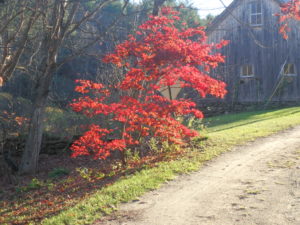
Japanese Red Maple is rated 5 plant but has survived 40 years in my colder Zone 4 garden
I have a Japanese red maple (Acer palmatum) that is rated as a Zone 5 plant, but is now over 40 years old. When it was a young plant it often lost branches (or the tips of branches) after cold winters. I have never done anything to protect it from the cold, and I would rate it as a Zone 4 plant. The mother plant I Connecticut at my parents’ home is majestic. Here the cold has kept it small.
Roses are often susceptible to cold weather, but again, I have Zone 5 roses that have survived here. I cut them back in the spring to remove blackened or brown branches killed by the cold. Some years, particularly for luscious new roses, I use cut branches of evergreens to protect them. And some roses I buy and use as annuals.
Instead of putting your Christmas tree on the curb to be hauled away by the city, cut off all the branches and use them around roses or other tender small shrubs. I stand up the branches leaning them against a rose, forming a teepee. Does this really make a difference? I don’t know. It will break the wind, but the temperature can’t be much different.
I love winter and I cross-country ski even when the temperatures are in the single digits. I don’t fear for my plants when we have a cold snap. After all, if something dies, it opens up a new place in the garden for an exciting new plant. So stop your grumbling – unless it keeps you warm!
Read Henry’s blog posts at https://dailyuv.com/henryhomeyer. Henry is a lifetime Master Gardener and is the author of 4 gardening books.
End of Year Reflections
Posted on Tuesday, December 26, 2017 · Leave a Comment
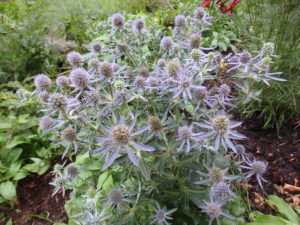
Eryngium
This was a good gardening year for me. Although we had some rainy times, and some hot, dry times, overall the weather was conducive to good plant growth. As usual, I tried a number of new things. Here are some of the things I tried this year.
In the vegetable garden I grew a new potato variety that I liked a lot called “Magic Molly”. It is sold by Fedco Seed Coop as a fingerling, but if you let them keep growing, the potatoes get to be quite large. I love the color: a purple so deep it is almost black when picked. It is dark colored inside and out, and keeps its color quite well when cooked, so it is good looking in a stew. Some purple potatoes turn gray when cooked, which is less appealing.
I tried a new (to me) tomato this year, a hybrid from Burpee Seed Company called Brandy Boy. I met the CEO of Burpee, George Ball, at the Chelsea Flower Show in London. He told me that Brandy Boy was earlier than Brandywine, my favorite heirloom tomato, and that it had disease resistance that heirlooms don’t have. He said that the flavor was comparable to Brandywine, and I agree. Very tasty.
In order to get Brandy Boy this year I had to buy plants from Burpee – I only learned about it in late May, much too late to start plants from seed. But I’m glad I did, it gave me a chance to try it this year. Next year I will plant seeds indoors in April, which is much more economical. I checked my local nurseries for plants last May, but no one had any.
Over the years my vegetable garden has gotten shadier and shadier. Now I don’t get direct sun until mid-morning, and it gets behind trees in late afternoon. So I get about 6 hours of prime sun, with sun filtered through trees at other times. I compared notes with other growers who get bigger yields, and know that sun is a major factor. I would cut down the offending trees, but most are on my neighbors’ property. Sigh.
I planted strawberries last summer, the first time in years. Strawberries are short-lived perennial plants – three years is about all one generally gets from a planting. The first year the plants will bloom, but growers advise picking off all the blossoms so that the roots and plants will develop better. I did that, and anticipate a good crop next June.
Most strawberries are sensitive to length of day, and produce heavy crops only in June. But now there are day-neutral plants, and everbearing plants that will produce some berries all summer and into the fall. This time I chose a June-bearing variety as there is a new insect pest, the spotted-winged drosophila that is mostly present late in the season. Hopefully this fruit fly won’t arrive until my crop has finished producing.
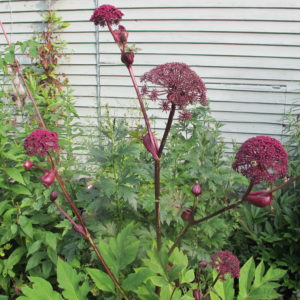
Angelica
In the flower garden I tried a new biennial, angelica (Angelica archangelica) and was delighted with it. This is a tall plant that produces globes of deep purple florets in globes about two to three inches across. Not only is it gorgeous, it attracts bees like crazy.
Like all biennials, angelica only blooms at the end of its second year of growth, then dies. I planted some of the seeds this year, but if I want it to flower next year I will have to buy another plant, and this one cost even more than a perennial flower. That leads me to believe it is not an easy flower to grow.
I was delighted to see that I finally have the proper soil for my sea holly, also called Eryngium. Sea holly has wonderful bluish flowers with spiky appendages around the globe-shaped blossoms that resemble globe thistle.
I have tried numerous times to get the proper soil to accommodate its needs, and finally got it to over winter and flower in year two. It hates good rich soil, and will only overwinter in sandy, nutrient-poor soil. So I created a spot for it by digging up some driveway soil and replacing my good soil. Bingo. It worked.
This was a great year for daylilies, which continued to bloom through much of September, even varieties that are normally finished in mid-August. I have no idea why they bloomed for such a long period, but enjoyed the show. You may not think of daylilies as cut flowers, but a scape (stem) cut with multiple buds will continue to open the buds and bloom, day after day. Just place the vase where it gets some good direct sun each day.
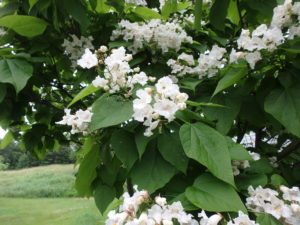
Catalpa
I planted 2 woody plants this summer: a catalpa tree and a shrub called button bush (Cephalanthus occidentalis). The catalpa will be a large specimen tree on a section of lawn that I always left for badminton. Given how little I play, I gave the lawn over to a magnificent flowering tree. It is 10 feet tall, and will get to be 40 or so, blooming in late June and into July. It’s fragrant, too.
Button bush, a native plant, likes moist soil and sun to part shade. I have plenty of moist soil, so planted one near my brook. It produces neat, round white blossoms in early summer.
I wish you all a great gardening year for 2018. May your veggies produce well, your flowers surprise you, and the Japanese beetles fly past your roses and land next door.
Henry is a UNH Master Gardener and the author of 4 gardening books. His website is www.Gardening-Guy.com. Henry blogs at www.dailyuv.com.































